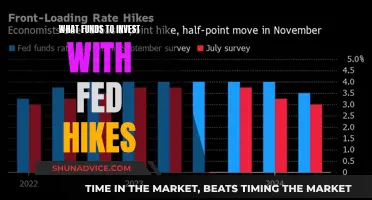
The Thrift Savings Plan (TSP) is a retirement investment program offered to US federal employees and members of the uniformed services. The TSP F Fund, or Fixed Income Index Investment Fund, is a mutual fund that invests in a broad range of debt instruments, including US corporate and government-backed investment-grade bonds. The F Fund's objective is to match the performance of the US bond market, such as the Bloomberg US Aggregate Bond Index or the Barclays Capital US Aggregate Bond Index. While the F Fund carries market, credit, inflation, and prepayment risks, its overall risk is relatively low compared to other fixed-income investments due to its focus on investment-grade securities. As a result, it offers the potential for higher long-term returns than short-term securities like the G Fund. However, investors should be aware of the recent decline in the bond market and consider the potential for further interest rate increases when deciding whether to invest in the TSP F Fund.
| Characteristics | Values |
|---|---|
| Investment type | Fixed Income Index Investment Fund |
| Investment objective | Match the performance of the Bloomberg U.S. Aggregate Bond Index |
| Assets | $33.1 billion |
| Total expense ratio | $0.490/$1,000 account balance 0.049% (4.9 basis points) |
| Benchmark index | Bloomberg U.S. Aggregate Bond Index |
| Asset manager(s) | BlackRock Institutional Trust Company, N.A. State Street Global Advisors Trust Company |
| Inception date | 29/01/1988 |
| Top ten holdings as of | 31/12/2023 |
| Average annual returns details as of | 31/12/2023 |
| Net administrative expense ratio | $0.480/$1,000 account balance 0.048% (4.8 basis points) |
| Investment expense ratio | $0.000/$1,000 account balance 0.000% (0.0 basis points) |
| Overall risk | Relatively low compared to other fixed-income investments |
| Risk of loss | Yes |
What You'll Learn

The F Fund's performance and risks
The F Fund, or Fixed Income Index Investment Fund, is a broadly diversified U.S. bond index fund. It uses a "passive management" (indexing) investment approach, designed to match the performance of the Bloomberg U.S. Aggregate Bond Index, a broad index representing the U.S. bond market. The F Fund provides broad exposure to U.S. investment-grade bonds, investing about 30% in corporate bonds and 70% in U.S. government bonds of all maturities.
As of October 2024, the fund has a compound annual growth rate of 5.2%, an annualized standard deviation of 4.2%, and a Sharpe Ratio of 0.24. An initial investment of $1,000 in August 1990 would have been worth $5,647 in October 2024. The worst drawdown since inception has been -18.0%.
The F Fund has historically been considered a safe fund, compounding at 7.0% per year since its inception in January 1988, with a maximum drawdown of -6.6%. However, looking at a longer time horizon, from 1900 to 1980, U.S. government bonds provided an annualized real return of only 0.2%.
The F Fund is subject to several types of risk, including:
- Inflation risk: the possibility that the bond portfolio's nominal return may not be high enough to offset the reduction in purchasing power due to inflation.
- Interest rate risk: an increase in interest rates may lead to a decrease in the price of the bonds in the portfolio.
- Credit risk: the possibility of a company or government's credit quality declining, resulting in a loss of some or all of the investment.
- Income risk: the potential for the fund's income to decline due to falling interest rates.
- Market risk: F Fund returns fluctuate with the bond market's returns.
- Credit default risk: the possibility that principal and interest payments on the bonds that comprise the index will not be paid.
- Prepayment risk: if interest rates fall, there is a chance that bonds in the index will be paid back early, forcing reinvestment at lower rates.
Despite these risks, the overall risk of the F Fund is considered relatively low compared to other fixed-income investments in the market. This is because the F Fund includes only investment-grade securities, and its performance tends to be less volatile when combined with stock funds in a retirement portfolio.
A Beginner's Guide to Mutual Fund Investing
You may want to see also

How the F Fund compares to the G Fund
The F Fund and the G Fund are two of the five core investment funds available in the Thrift Savings Plan (TSP) offered to all US government employees. While the G Fund is intended for very conservative investors, the F Fund represents the next step up the risk/reward ladder in the TSP.
The G Fund is invested in short-term US Treasury securities and guarantees the return of the investor's principal. It has the lowest risk of the five funds and offers a higher return than inflation without exposing the fund to risk of default or changes in market prices. The payment of principal and interest is guaranteed by the US government. The interest rate on the G Fund is calculated based on the weighted average yield of all US Treasury securities with more than four years to maturity and changes monthly.
On the other hand, the F Fund is a fixed-income investment fund that invests in a wide range of debt instruments, including publicly traded treasury and government agency securities, corporate and non-corporate bonds, and asset-backed securities. The F Fund does not guarantee the return of the investor's principal. It has relatively low risk because it includes only investment-grade securities and is broadly diversified. The F Fund's investment objective is to match the performance of the Bloomberg Barclays US Aggregate Bond Index, a broad index representing the US bond market. The F Fund's returns are subject to market risk and will fluctuate with the returns in the bond market.
In terms of returns, the F Fund offers the opportunity to earn higher rates of return over the long term compared to the G Fund. However, the G Fund has historically provided the lowest rate of return among the core funds. In recent years, the G Fund has delivered lower returns, with an average US inflation rate of around 3% per year, causing the fund to fail to maintain purchasing power. In contrast, the F Fund has compounded at 7.0 percent per year since becoming available in January 1988, with a tolerable maximum drawdown of -6.6 percent.
In summary, the F Fund offers a higher potential for returns but comes with greater risk and volatility compared to the G Fund. The G Fund is a more conservative option with guaranteed principal protection and a lower risk of loss, making it suitable for investors seeking capital preservation and stability.
Funding Sources for Your Real Estate Investment
You may want to see also

The F Fund's historical returns
The TSP F Fund (Fixed Income Index Investment Fund) is a broadly diversified U.S. bond index fund. The fund uses a "passive management" (indexing) investment approach, designed to match the performance of the Bloomberg U.S. Aggregate Bond Index, a broad index representing the U.S. bond market. The F Fund has a compound annual growth rate of 5.2% as of 16 October 2024. An initial investment of $1,000 on 31 August 1990 would be worth $5,647 on 16 October 2024.
The F Fund has historically provided higher returns than the G Fund. The F Fund has compounded at 7.0 percent per year since it became available in January 1988, with a maximum drawdown of -6.6 percent. However, from 1900 to 1980, U.S. government bonds provided an annualized real return of only 0.2 percent.
The F Fund's performance is also influenced by interest rates and market trends. In recent years, interest rates have been at multi-decade lows, impacting the returns on bond funds. The F Fund has experienced a decline in value since May, coinciding with a rise in the yield on 10-year Treasurys.
The F Fund's returns are also subject to market risk, credit default risk, inflation risk, and prepayment risk. These risks can impact the overall returns of the fund.
Unlocking Down Payment Strategies for Your Next Investment Property
You may want to see also

The F Fund's investment strategy
The F Fund, or Fixed-Income Investment Index Fund, is one of the five core investment funds available in the Thrift Savings Plan (TSP). TSP is a direct-contribution retirement plan offered to US government employees.
The F Fund represents the next step up the risk/reward ladder in the TSP. It invests in a wide range of debt instruments, including publicly traded treasury and government agency securities, corporate and non-corporate bonds, and asset-backed securities.
The F Fund has an investment objective to match the performance of the Bloomberg US Aggregate Bond Index, a broad index representing the US bond market. As of December 31, 2023, the index included 13,334 notes and bonds.
The F Fund is managed by BlackRock Institutional Trust Company, N.A. and State Street Global Advisors Trust Company. These companies select a large representative sample of the various types of asset-backed, US government, corporate, and foreign government securities included in the overall index.
The F Fund has experienced gains during periods of falling interest rates, as bond prices rise. Over the long term, F Fund returns are expected to exceed those of the G Fund, which invests in very low-risk, low-yield government bonds. However, the F Fund also has greater price volatility.
The F Fund has provided an average annual return of 7.0% since its inception in January 1988, with a maximum drawdown of -6.6%. However, it's important to consider the broader context of the bond market, as interest rates have been at multi-decade lows recently, which could impact future returns.
HOA Fund Investment Strategies: A Guide to Smart Investing
You may want to see also

The F Fund's suitability for your portfolio
The F Fund, or Fixed Income Index Investment Fund, is a part of the Thrift Savings Plan (TSP) offered to all US government employees. It is a step up from the G Fund on the risk/reward ladder. The F Fund's objective is to match the performance of the Bloomberg US Aggregate Bond Index (or the Barclays Capital US Aggregate Bond Index, according to another source), which is a broad index representing the US bond market.
The F Fund is a good option for investors who want to earn higher rates of return over the long term than they would from short-term securities such as the G Fund. While the overall risk is relatively low compared to other fixed-income investments, investors are still exposed to market and inflation risk. F Fund returns move up and down with the returns in the bond market, and investors are exposed to the possibility that principal and interest payments on the bonds will not be paid (credit default risk). F Fund investments may also not outpace or grow enough to offset the reduction in purchasing power (inflation risk). There is also prepayment risk, which is the probability that if interest rates fall, bonds that are represented in the index will be paid back early, forcing lenders to reinvest at lower rates.
The F Fund is a good option for investors with a retirement portfolio that contains stock funds, as it will tend to be less volatile than one that contains stock funds alone. However, investors should be aware that the F Fund has experienced volatility in recent years due to rising interest rates and bond prices.
In summary, the F Fund is a suitable option for investors seeking higher returns than those offered by short-term securities and who are comfortable with the associated market and inflation risks. It is a good choice for those with a retirement portfolio containing stock funds, as it will help to reduce volatility. However, investors should be mindful of the recent volatility in the F Fund due to rising interest rates.
Midcap Fund: SBI Magnum a Smart Investment Choice?
You may want to see also
Frequently asked questions
The TSP F Fund, also known as the Fixed Income Index Investment Fund, is a fund that represents the next step up the risk/reward ladder in the TSP. This fund invests in a wide range of debt instruments, including publicly traded treasury and government agency securities, corporate and non-corporate bonds, and asset-backed securities (ABS).
The TSP F Fund offers investors the opportunity to earn higher rates of return over the long term compared to short-term securities such as the G Fund. The overall risk is relatively low compared to other fixed-income investments in the market as the F Fund only includes investment-grade securities. Additionally, the F Fund can provide greater diversification for investors by including small- to mid-sized U.S. companies, offering the potential for higher growth.
The TSP F Fund is subject to market risk as it moves up and down with the returns in the bond market. It is also exposed to credit (default) risk, inflation risk, and prepayment risk. The longer-term nature of the investments in the F Fund can result in greater volatility and potential losses when interest rates change.
The TSP F Fund offers higher potential returns over the long term compared to the G Fund, which has historically provided the lowest rate of return among the core funds. However, it is important to note that the F Fund comes with credit and price risk, and there may be periods of loss. Investors should consider their risk tolerance and investment horizon when deciding between the F Fund and other options, such as the G Fund, which is considered the safest and least risky choice.







